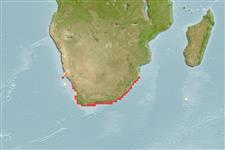Teleostei (teleosts) >
Atheriniformes (Silversides) >
Atherinidae (Silversides) > Atherininae
Etymology: Atherina: Greek, atherina, the Greek name for the eperlane; 1770 (Ref. 45335).
More on author: Valenciennes.
Environment: milieu / climate zone / depth range / distribution range
Ecology
Marine; freshwater; brackish; pelagic-neritic. Subtropical; 27°S - 35°S
Southeast Atlantic: restricted from Lüderitz, Namibia to northern Natal, South Africa.
Length at first maturity / Size / Weight / Age
Maturity: Lm 4.0 range ? - ? cm
Max length : 11.0 cm SL male/unsexed; (Ref. 7248)
Forms schools along the coast and in estuaries, especially during spring (Ref. 3302). Also found in coastal lakes (Ref. 7248). Small individuals filter out small organisms such as phytoplankton and rotifers. Above 3.5 cm TL, it feeds mostly on crustaceans especially amphipods taken from the water column as well as off the bottom. Preyed upon by fishes and birds (Ref. 7248).
Life cycle and mating behavior
Maturity | Reproduction | Spawning | Eggs | Fecundity | Larvae
Skelton, P.H., 1993. A complete guide to the freshwater fishes of southern Africa. Southern Book Publishers. 388 p. (Ref. 7248)
IUCN Red List Status (Ref. 130435: Version 2024-2)
Threat to humans
Harmless
Human uses
Fisheries: subsistence fisheries; bait: usually
Tools
Special reports
Download XML
Internet sources
Estimates based on models
Preferred temperature (Ref.
123201): 14.3 - 23.9, mean 19.5 °C (based on 14 cells).
Phylogenetic diversity index (Ref.
82804): PD
50 = 0.5312 [Uniqueness, from 0.5 = low to 2.0 = high].
Bayesian length-weight: a=0.00794 (0.00438 - 0.01441), b=3.14 (2.98 - 3.30), in cm total length, based on LWR estimates for this species & (Sub)family-body (Ref.
93245).
Trophic level (Ref.
69278): 3.4 ±0.46 se; based on food items.
Resilience (Ref.
120179): Medium, minimum population doubling time 1.4 - 4.4 years (Preliminary K or Fecundity.).
Fishing Vulnerability (Ref.
59153): Low vulnerability (10 of 100).
